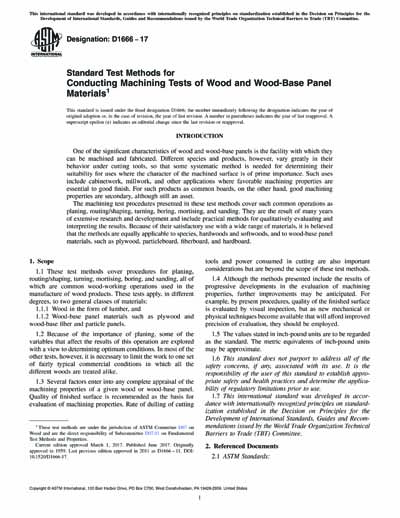Historical
ASTM D1666-17
Standard Test Methods for Conducting Machining Tests of Wood and Wood-Base Panel Materials
1.1 These test methods cover procedures for planing, routing/shaping, turning, mortising, boring, and sanding, all of which are common wood-working operations used in the manufacture of wood products. These tests apply, in different degrees, to two general classes of materials:...
1.2 Because of the importance of planing, some of the variables that affect the results of this operation are explored with a view to determining optimum conditions. In most of the other tests, however, it is necessary to limit the work to one set of fairly typical commercial conditions in which all the different woods are treated alike.
1.3 Several factors enter into any complete appraisal of the machining properties of a given wood or wood-base panel. Quality of finished surface is recommended as the basis for evaluation of machining properties. Rate of dulling of cutting tools and power consumed in cutting are also important considerations but are beyond the scope of these test methods.
1.4 Although the methods presented include the results of progressive developments in the evaluation of machining properties, further improvements may be anticipated. For example, by present procedures, quality of the finished surface is evaluated by visual inspection, but as new mechanical or physical techniques become available that will afford improved precision of evaluation, they should be employed.
1.5 The values stated in inch-pound units are to be regarded as the standard. The metric equivalents of inch-pound units may be approximate.
1.6 This standard does not purport to address all of the safety concerns, if any, associated with its use. It is the responsibility of the user of this standard to establish appropriate safety and health practices and determine the applicability of regulatory limitations prior to use.
1.7 This international standard was developed in accordance with internationally recognized principles on standardization established in the Decision on Principles for the Development of International Standards, Guides and Recommendations issued by the World Trade Organization Technical Barriers to Trade (TBT) Committee.
Content Provider
ASTM International [astm]






